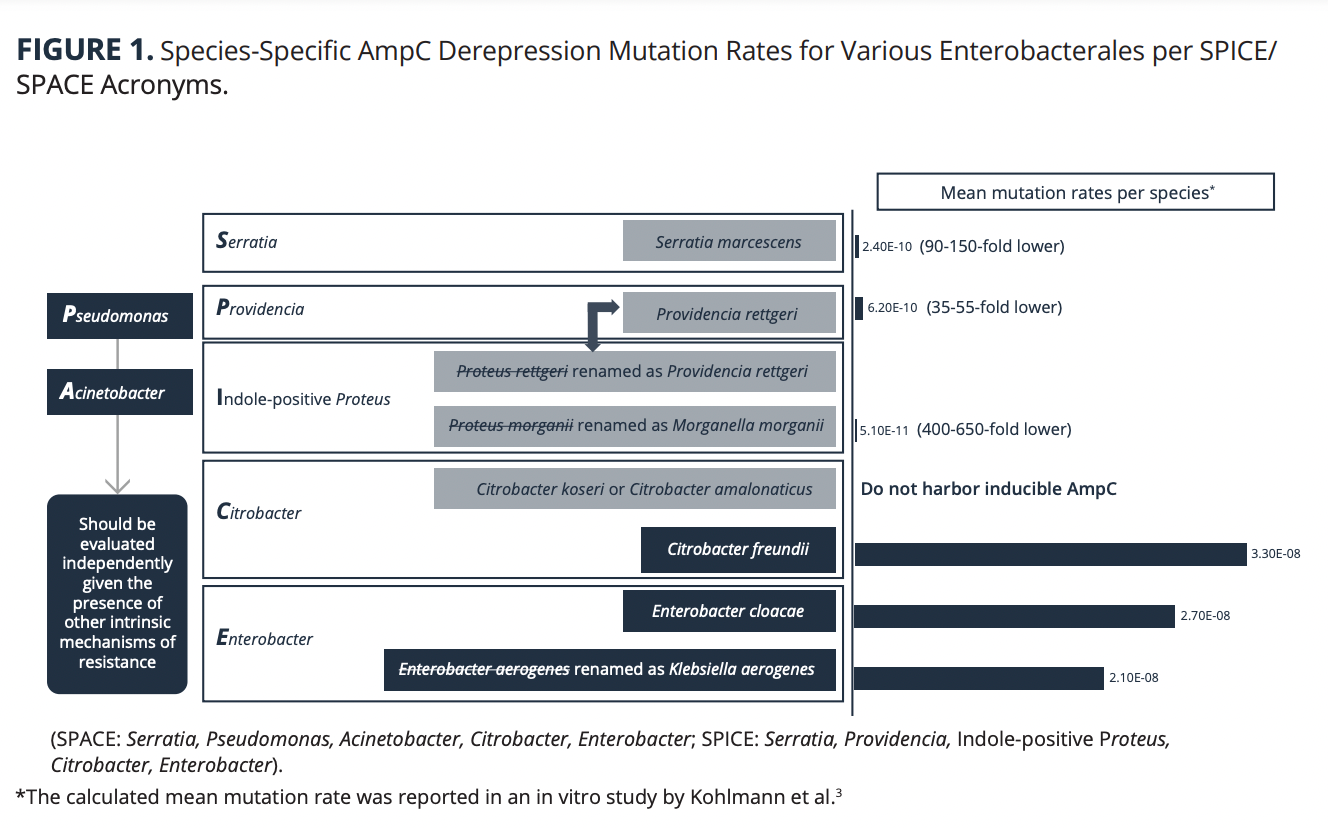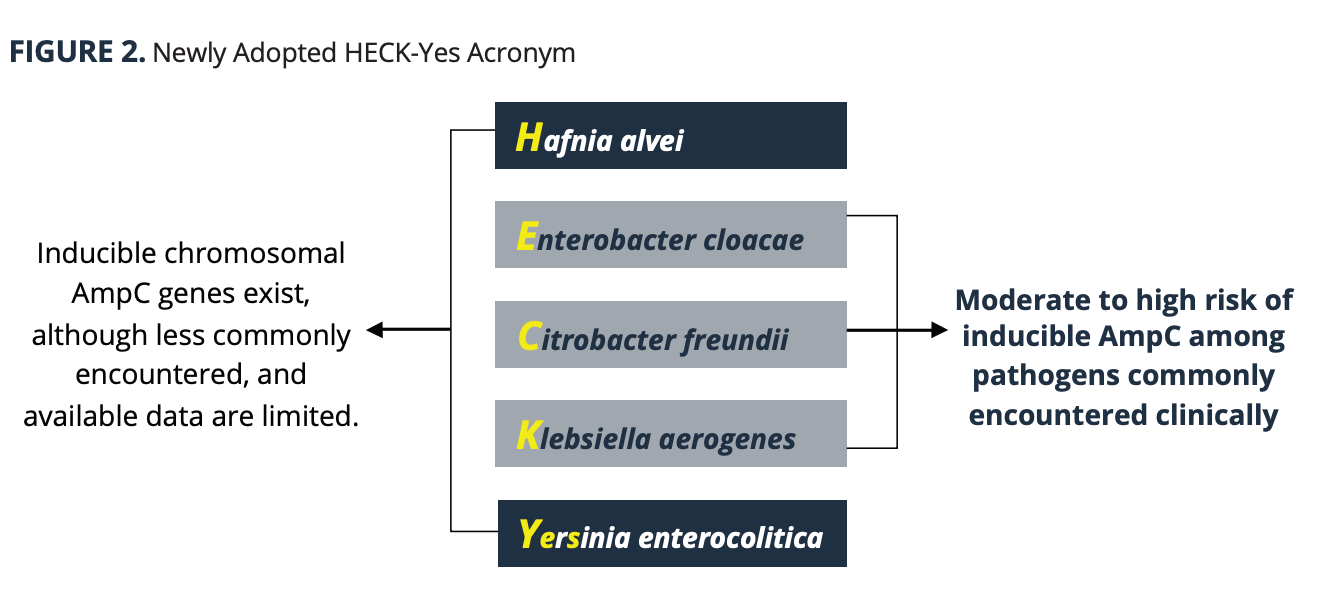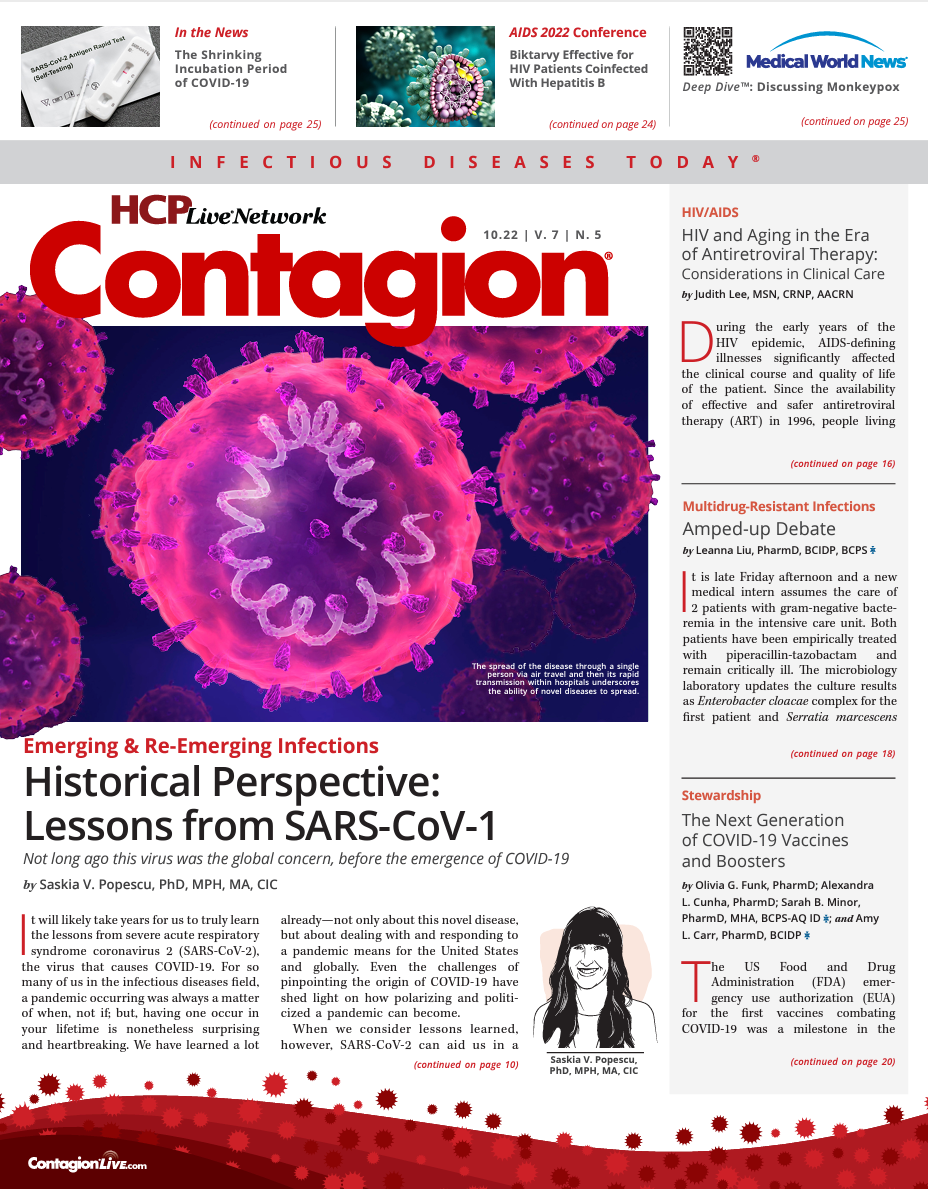Amped-up Enterobacterales Debate
Demystifying clinical data for treating invasive AmpC-harboring Enterobacterales.
It is late Friday afternoon and a new medical intern assumes the care of 2 patients with gram-negative bacteremia in the intensive care unit.
Both patients have been empirically treated with piperacillin-tazobactam and remain critically ill. The microbiology laboratory updates the culture results as Enterobacter cloacae complex for the first patient and Serratia marcescens for the other. At this point, the intern vaguely recalls the SPACE or SPICE acronyms (SPACE: Serratia, Pseudomonas, Acinetobacter, Citrobacter, Enterobacter; SPICE: Serratia, Providencia, Indole-positive Proteus, Citrobacter, Enterobacter), but after a quick literature search, realizes that neither provides a clear answer as to which organisms are included.
Even more perplexing, the available primary literature demonstrates conflicting data for optimal treatment. More confused than ever, the intern calls his infectious diseases colleagues with a series of questions: Are these really AmpC-producing organisms? Should I consider them similarly? Do I need to change antibiotics for either patient before susceptibility results? And if the bug is susceptible, will piperacillin-tazobactam be an effective treatment?
For many clinicians, with or without infectious disease training, this scenario may sound familiar. AmpC-producing organisms are unique, given the scarcity of clinical data to provide definitive answers as well as the confusion that results from the initial susceptibility report.
Complicating matters, the available rapid diagnostic tests do not differentiate between AmpC-expression levels or detect plasmid-mediated AmpC genes routinely. Thus, clinicians must rely on their empiric knowledge to choose the appropriate antibiotics for patients. AmpC β-lactamases are class C serine β-lactamase enzymes that effectively hydrolyze many β-lactam antibiotics, including third-generation cephalosporins such as ceftriaxone and ceftazidime. AmpC production levels can be summarized as either stable or inducible, and vary by host pathogen. Stable or constitutive AmpC production occurs by chromosomal derepression or plasmid-mediated gene transfer.1

Organisms with stable AmpC expression, such as Escherichia coli and Salmonella species (spp), are more straightforward to treat because the enzymes are always present, but not overexpressed, so clinicians can pick the active agent based on the susceptibility panel. Organisms harboring inducible AmpC, however, represent a greater challenge due to the possibility of treatment-emergent resistance. Such inducible resistance can develop after even a few doses of the wrong antibiotics.2
Historically, clinicians identifying AmpC-producing pathogens have been aided by using acronyms such as SPACE and SPICE. Despite their widespread use, new data provide a rationale for retiring these popular terms (Figure 1) and have been recently summarized in the Infectious Diseases Society of America guidance document on the treatment of antimicrobial-resistant gram-negative infections.1

Contemporary knowledge now better defines inducible, clinically relevant AmpC production in Enterobacter cloacae, Citrobacter freundii, and Klebsiella aerogenes (ECK). Inducible resistance has been reported within a range of 8% to 40% for these pathogens specifically.1 Hafnia alvei (H) and Yersinia enterocolitica (Yes) are less commonly encountered, but still considered clinically relevant. Putting these terms together, the updated acronym HECK-Yes has been proposed (Figure 2) and more accurately describes the pathogens that clinicians should commit to memory.
In contrast to these pathogens, mutation rates are considerably lower in Providencia, Serratia spp, and Morganella morganii.3 In light of a better understanding of the variability in inducible AmpC production, responses to a concerned intern have certainly shifted in recent years. Specifically, treatment for invasive infections caused by ECK organisms should be limited to cefepime or a carbapenem, but not piperacillin-tazobactam.
Historically, carbapenems have been regarded as the primary therapeutic choice, but a suitable alternative is urgently needed due to the rise of carbapenem-resistant organisms. In vitro data have shown that cefepime is both a weak AmpC inducer and stable against hydrolysis by AmpC.4
Although developed as a β-lactamase inhibitor, tazobactam is not effective in vitro for inhibiting AmpC hydrolysis, which makes piperacillin-tazobactam a less desirable choice.5 Consensus among experts favors cefepime over piperacillin-tazobactam based on recent clinical data,6-8 even though a head-tohead comparison has not been conducted and the evidence is less than conclusive.
Given the noninferior efficacy compared with meropenem, cefepime should be prioritized for ECK pathogens whenever the suspicion of extended-spectrum β-lactamase (ESBL) coproduction is low.9 When Enterobacterales isolates exhibit cefepime dose-dependent susceptibility or a minimum inhibitory concentration of 4 to 8 mcg/mL, carbapenems may be a reasonable alternative.
The debate surrounding the role of piperacillin-tazobactam is fueled by the potential for inducible resistance and uncontrolled clinical data. Although not statistically significant, findings from at least 2 studies have shown numerically higher rates of mortality among patients treated with piperacillin-tazobactam compared with alternative agents such as cefepime or meropenem.10,11
In a 2019 meta-analysis of 13 observational studies including 1021 patients, the 30-day mortality while being treated for AmpC-producing Enterobacterales bacteremia was not significantly different between patients receiving piperacillin-tazobactam and those receiving carbapenems (odds ratio, 1.13; 95% CI, 0.58-2.05).12
In the MERINO II open-label pilot study (NCT02437045), 72 patients with bacteremia caused by Enterobacter spp, K aerogenes, C freundii, M morganii, Providencia spp, or S marcescens were treated with piperacillin-tazobactam or meropenem. The piperacillin-tazobactam group had a significantly worse microbiological failure than the meropenem group, but the major composite outcome of death, microbiological failure, clinical failure, or microbiological relapse was not different (risk difference, 8%; 95% CI, –12% to 28%).13 Notably, data from MERINO II are hard to interpret due to the trial’s relatively small sample size and discrepant outcome results. A larger clinical trial is required to determine whether piperacillin-tazobactam can be a successful carbapenem-sparing strategy, particularly in hospitalized, critically ill patients.
Piperacillin-tazobactam has a broader spectrum coverage for the treatment of polymicrobial infections than cefepime, which is beneficial for patients with intra-abdominal infections who may need coverage against enterococcus and anaerobic bacteria. Piperacillin-tazobactam may be a viable alternative for treating noncritically ill patients among those showing evidence of clinical improvement. Regardless of the antibiotic selection, dosing for both cefepime and piperacillin-tazobactam should always be optimized for invasive infections to maximize pharmacokinetic exposures and pharmacodynamic killing. Both drugs should be infused over at least 3 hours whenever possible, and renal function should be monitored carefully to minimize the risk of neurotoxicity.1
What about the other pathogens that may not produce clinically relevant levels of AmpC, specifically for the treatment of invasive infections due to S marcescens, Providencia, and M morganii? Treatment for those organisms presents less of a dilemma because clinicians can take susceptibility results at face value and consider de-escalation to ceftriaxone if susceptible. Non–β-lactam options such as fluoroquinolones or trimethoprim-sulfamethoxazole (TMP-SMX) are not a substrate for AmpC hydrolysis, and therefore should be considered either intravenously or as oral step-down therapy.
Although no evidence from high-quality clinical trials exists to establish the role of fluoroquinolones or TMP-SMX for the treatment of AmpC Enterobacterales non–urinary tract infections, data from multiple observational studies have demonstrated these agents to be reasonable oral choices for patients who have clinically improved and are able to absorb oral antibiotics.14,15 A related question stems from the availability of novel β-lactam-β-lactamase inhibitor combination agents (ie, imipenem-cilastatin-relebactam, meropenem-vaborbactam, ceftolozane-tazobactam, and ceftazidime-avibactam) as well as newer β-lactams (ie, cefiderocol) that are stable against AmpC hydrolysis.
What role should these agents play in the treatment of invasive infections, particularly in the empiric setting? Both imipenem-cilastatin-relebactam and meropenem-vaborbactam are novel carbapenem-β-lactamase inhibitor combinations, but their ability to withstand AmpC hydrolysis is not the same. Relebactam is a very good AmpC inhibitor, but vaborbactam is not.16 Regardless, adding a novel inhibitor to a carbapenem is rarely necessary for ECK pathogens because carbapenems alone retain potent in vitro activity against both AmpC and ESBL-producing organisms. Both agents should be reserved for life-threatening infections caused by organisms demonstrating carbapenem resistance. When such resistance occurs, the underlying mechanisms vary, and may include carbapenemase production and porin loss in addition to AmpC and ESBL enzymes.16
On balance, novel cephalosporin-β-lactamase inhibitor combinations may offer an advantage when carbapenem resistance evolves; however, each should be evaluated independently. Because tazobactam is a weaker AmpC β-lactamase inhibitor compared with avibactam in vitro,5,16 ceftolozane-tazobactam may be a less desirable treatment option.17
The multicenter, open-label, noninferiority MERINO III trial (NCT04238390) was designed to compare ceftolozane-tazobactam vs meropenem in adult patients with bloodstream infection caused by ESBL or AmpC Enterobacterales. Unfortunately, the study currently has been withdrawn due to the impact of the COVID-19 pandemic.18 In treating cefepime- or carbapenem-resistant Enterobacterales when novel agents are justified, ceftazidime-avibactam presents as a rational alternative. Cefiderocol has also been shown to exhibit in vitro activity against AmpC, providing another viable carbapenem-sparing option.19
Although novel agents offer new tools to fight against difficult pathogens, novel mechanisms of resistance evolve inevitably. Ceftazidimeavibactam has already been reported as defeated in the case of studies following cefepime treatment in patients in the absence of prior novel agent exposure.20 The treated isolates in the case study also demonstrated coresistance to cefiderocol. A modification in the AmpC enzyme was found to be responsible for the resistant phenotype demonstrating the incredible plasticity of β-lactamase enzymes.
The challenge in demystifying inducible AmpC Enterobacterales is far from over. Clinicians must evaluate patient-specific and infection-specific factors when managing AmpC-producing Enterobacterales infections. ECK pathogens (E cloacae, C freundii, and K aerogenes) are the most notable clinical isolates with significant AmpC induction potential, and first-line agents such as cefepime or carbapenem need to be prioritized for treating serious infections.
Many important questions remain. Clinicians eagerly look forward to future large-scale randomized controlled studies to settle the amped-up debate.
References
- Tamma PD, Aitken SL, Bonomo RA, Mathers AJ, van Duin D, Clancy CJ. Infectious Diseases Society of America guidance on the treatment of AmpC β-lactamase-producing Enterobacterales, carbapenem-resistant Acinetobacter baumannii, and Stenotrophomonas maltophilia infections. Clin Infect Dis. 2022;74(12):2089-2114. doi:10.1093/cid/ciab1013
- Jacobson KL, Cohen SH, Inciardi JF, et al. The relationship between antecedent antibiotic use and resistance to extended-spectrum cephalosporins in group I beta-lactamase-producing organisms. Clin Infect Dis. 1995;21(5):1107-1113. doi:10.1093/clinids/21.5.1107
- Kohlmann R, Bähr T, Gatermann SG. Species-specific mutation rates for AmpC derepression in Enterobacterales with chromosomally encoded inducible AmpC β-lactamase. J Antimicrob Chemother. 2018;73(6):1530-1536. doi:10.1093/jac/dky084
- Negri MC, Baquero F. In vitro selective concentrations of cefepime and ceftazidime for AmpC beta-lactamase hyperproducer Enterobacter cloacae variants. Clin Microbiol Infect. 1999;5(suppl 1):S25-S28. doi:10.1111/j.1469-0691.1999.tb00721.x
- Papp-Wallace KM, Mack AR, Taracila MA, Bonomo RA. Resistance to novel β-lactam-β-lactamase inhibitor combinations: the “price of progress.” Infect Dis Clin North Am. 2020;34(4):773-819. doi:10.1016/j.idc.2020.05.001
- Tamma PD, Girdwood SC, Gopaul R, et al. The use of cefepime for treating AmpC β-lactamase-producing Enterobacteriaceae. Clin Infect Dis. 2013;57(6):781-788. doi:10.1093/cid/cit395
- Tan SH, Ng TM, Chew KL, et al. Outcomes of treating AmpC-producing Enterobacterales bacteraemia with carbapenems vs non-carbapenems. Int J Antimicrob Agents. 2020;55(2):105860. doi:10.1016/j.ijantimicag.2019.105860
- Harris PN, Wei JY, Shen AW, et al. Carbapenems versus alternative antibiotics for the treatment of bloodstream infections caused by Enterobacter, Citrobacter or Serratia species: a systematic review with meta-analysis. J Antimicrob Chemother. 2016;71(2):296-306. doi:10.1093/jac/dkv346
- Lee NY, Lee CC, Li CW, et al. Cefepime therapy for monomicrobial Enterobacter cloacae bacteremia: unfavorable outcomes in patients infected by cefepime-susceptible dose-dependent isolates. Antimicrob Agents Chemother. 2015;59(12):7558-7563. doi:10.1128/AAC.01477-15
- Cheng L, Nelson BC, Mehta M, et al. Piperacillin-tazobactam versus other antibacterial agents for treatment of bloodstream infections due to Ampc β-lactamase-producing Enterobacteriaceae. Antimicrob Agents Chemother. 2017;61(6):e00276-17. doi:10.1128/AAC.00276-17
- Harris PNA, Peri AM, Pelecanos AM, Hughes CM, Paterson DL, Ferguson JK. Risk factors for relapse or persistence of bacteraemia caused by Enterobacter spp: a case-control study. Antimicrob Resist Infect Control. 2017;6:14. doi:10.1186/s13756-017-0177-0
- Cheng MP, Lee RS, Cheng AP, et al. Beta-lactam/beta-lactamase inhibitor therapy for potential AmpC-producing organisms: a systematic review and meta-analysis. Open Forum Infect Dis. 2019;6(7):ofz248. doi:10.1093/ofid/ofz248
- Stewart AG, Paterson DL, Young B, et al; MERINO Trial Investigators and the Australasian Society for Infectious Disease Clinical Research Network (ASID-CRN). Meropenem versus piperacillin-tazobactam for definitive treatment of bloodstream infections caused by AmpC β-lactamase-producing Enterobacter spp, Citrobacter freundii, Morganella morganii, Providencia spp, or Serratia marcescens: a pilot multicenter randomized controlled trial (MERINO-2). Open Forum Infect Dis. 2021;8(8):ofab387. doi:10.1093/ofid/ofab387
- Tamma PD, Conley AT, Cosgrove SE, et al; Antibacterial Resistance Leadership Group. Association of 30-day mortality with oral step-down vs continued intravenous therapy in patients hospitalized with Enterobacteriaceae bacteremia. JAMA Intern Med. 2019;179(3):316-323. Published correction appears in JAMA Intern Med. 2019;179(11):1607.
- Punjabi C, Tien V, Meng L, Deresinski S, Holubar M. Oral fluoroquinolone or trimethoprim-sulfamethoxazole vs ß-lactams as step-down therapy for Enterobacteriaceae bacteremia: systematic review and meta-analysis. Open Forum Infect Dis. 2019;6(10):ofz364. doi:10.1093/ofid/ofz364
- Yahav D, Giske CG, Grāmatniece A, Abodakpi H, Tam VH, Leibovici L. New β-lactam-β-lactamase inhibitor combinations. Clin Microbiol Rev. 2020;34(1):e00115-20. Published correction appears in Clin Microbiol Rev. 2021;34(2):e00021-21.
- Papp-Wallace KM, Bethel CR, Caillon J, et al. Beyond piperacillin-tazobactam: cefepime and AAI101 as a potent β-lactam-β-lactamase inhibitor combination. Antimicrob Agents Chemother. 2019;63(5):e00105-19. doi:10.1128/AAC.00105-19
- Ceftolozane-tazobactam versus meropenem for ESBL and AmpC-producing Enterobacterales bloodstream infection (MERINO III). ClinicalTrials.gov. Updated May 19, 2022. Accessed Aug 12, 2022. https://clinicaltrials.gov/ct2/show/NCT04238390
- Karlowsky JA, Hackel MA, Tsuji M, Yamano Y, Echols R, Sahm DF. In vitro activity of cefiderocol, a siderophore cephalosporin, against gram-negative bacilli isolated by clinical laboratories in North America and Europe in 2015-2016: SIDERO-WT-2015. Int J Antimicrob Agents. 2019;53(4):456-466. doi:10.1016/j.ijantimicag.2018.11.007
- Shields RK, Iovleva A, Kline EG, Kawai A, McElheny CL, Doi Y. Clinical evolution of AmpC-mediated ceftazidime-avibactam and cefiderocol resistance in Enterobacter cloacae complex following exposure to cefepime. Clin Infect Dis. 2020;71(10):2713-2716. doi:10.1093/cid/ciaa355

